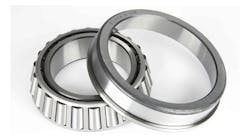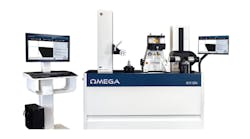Rugged Industrial Panel PCs for HMI
Larger Part Cleaning Systems
The problem being addressed by the U.S. Army was that wear and corrosion require the artillery personnel to replace chromium-coated spindles well before they reach their usable end-of-life. The spindle is the component that seals the chamber of the howitzer to hold pressure and prevent gas from leaking from the breech. Historically electroplated chromium coatings have been applied to the spindles, but wear and corrosion caused problems (such as a loss of seal), which leads to a shortened spindle life when the howitzers are subjected to typical usage.
Figure 1(a) illustrates the machined spindle component in the as-coated condition for the conventionally Cr-plated spindle, while Figure 1(b) shows a PVD-processed, CrN-coated spindle.
The goal for the engineers and scientists at the U.S. Army Armament Research and Development Center at the Benét Laboratories and Picatinny Arsenal was to identify an improved coating protection system for the spindles. The Army chose 12 separate coating systems for testing and evaluation. The Army’s results showed that of the 12 coating systems examined Phygen Coating Inc.’s CrN coating provided the best corrosion and wear protection.
PVD Coating Processes — Physical Vapor Deposition (PVD) involves the vaporization of atoms from a solid source, and the transportation and deposition of these atoms onto a substrate of interest. Some of the most commonly used PVD coatings are metal nitrides, such as TiN, CrN, TiAlN, and AlCrN, which are produced by bleeding low pressures of nitrogen gas into the PVD deposition chamber, allowing the metallic atoms vaporized from the metal target to react with the nitrogen gas during deposition on the substrate. PVD coatings are normally about 1-to-6 mm in thickness. (See Figure 2.)
Cathodic Arc Evaporation (CAE) is one of the most commonly used, commercially available PVD processes, as it produces coatings with extremely high levels of adhesion, cohesion, density and hardness. However, one drawback of the cathodic arc process is the ejection of relatively large (about 2-10 mm diameter) macroparticles from the target material. These macroparticles may become incorporated into the coating. (See Figure 3a.)
Macro-particles form when unwanted droplets of liquid metal splash from the arc source and land on the substrate during coating growth. As these particles are similar in size as the thickness of the PVD coating, and often are poorly adhered to the substrate, they are detrimental to the coating’s integrity, and are the reason why most PVD coatings provide poor corrosion protection.
Phygen has patented a modified CAE process called Arc Plasma Acceleration (APA), which can significantly reduce the number of macroparticles and other defects within the PVD coatings (see Figure 3b), and thereby significantly improve corrosion resistance.
Table 1 shows a comparison performed by the Army researchers into the size and concentration of macroparticles in conventional PVD-coated and APA-processed coatings.
The APA process uses a magnetic field generator to create a magnetic field with a distinctive cusp shape, which provides enhanced trapping of the plasma particles generated from the cathodic source. More than this, the APA process permits control over the growth of the coating both via the intensity of ion bombardment (through the plasma density control) and the energy of arriving particles (through the substrate bias potential.)
A critical point for the APA process is ensuring that a large number of ions are bombarding the surface with a velocity in a specific range, so that by tuning that range crystalline configurations with weaker bonding can be minimized while preserving the strongest bonds. This results in growth of a dense and highly textured coating, having a low defect content and an excellent metallurgical bond to the substrate.
Phygen’s PVD Coatings —Table 2 lists the various PVD coatings available from Phygen. The “plus” designation indicates that the coating structure includes an intermediate ion-nitrided layer, which can harden the surface layer in a steel substrate, to help support the PVD coating. The duplex CrN/DLC and CrN/SiC are relatively new coatings that exhibit lubricious surface characteristics, allowing them to be used in applications requiring solid lubrication. Photomicrographs showing sections through these bi-layer coatings are presented in Figure 4, showing that these duplex compositions also produce extremely dense coatings.
U.S. Army Testing Results — As part of the evaluation process, the U.S. Army at Benét Laboratories compared the performance of coatings produced by the APA process with conventional electroplated chromium (12 mm and 40 mm thick) and electroless, high-phosphorous nickel (40 mm thick.) Results of corrosion and wear testing are described below.
Corrosion Protection — The PVD coatings produced by Phygen’s APA process were a single layer CrN (3.5 mm thick) and a duplex CrN/SiC coating (total thickness of 3.5 mm.) Laboratory corrosion testing was performed according to the GM9540P cyclic corrosion testing specification, which included 30 cycles of 16 hour exposure to chloride solutions at 49oC. The results showed that the CrN PVD coating and the CrN/SiC duplex PVD coating produced using the APA process exhibited significantly better corrosion resistance than the chromium coatings, and equivalent corrosion resistance to the electroless high phosphorous nickel plate (see Figure 5.)
For comparison to other PVD processes, Figures 5 (c) and (f) illustrate the same corrosion-testing protocol for, respectively (c) a conventional cathodic arc-deposited CrN; and (f) a High-Power Impulse Magnetron Sputtering (HIPIMS) deposited nitride.
HIPIMS is a high power-density PVD process shown to produce higher-density coatings and significantly enhanced corrosion resistance over conventional PVD coatings. Note that the conventional CrN image in Figure 5 (c) is following just three cycles, as opposed to 30, illustrating the lack of corrosion protection provided with conventional cathodic arc. Significant improvement in corrosion protection is realized with the HIPIMS process versus conventional arc but the Army found that the best performance among the various coatings were those deposited by Phygen’s APA process.
Wear Resistance — PVD coatings are extremely hard (20-30 GPa) and this results in high levels of wear resistance for the PVD coatings (Table 3.) Wear rates were measured using the pin-on-disk technique. The measured wear rates for the PVD coatings were about 3.5 times better than electroless Ni-P, and nearly 40 time better than the electroplated chromium.
Functional Testing — Coated howitzer breech spindles were tested at the Aberdeen Test Center, initially involving live firing on a howitzer range, and to simulate combat conditions the spindles were weathered for 30 days in a caustic acid + acidic propellant by-product. This was followed by another round of firing plus a second weathering treatment.
Following this testing, conventional chromium coated spindles exhibited severe corrosion, but Phygen's PVD-coated spindles’ performance was significantly better. Following down-selection of the Phygen’s processed CrN from the original 12 coatings tested, more extensive testing involved firing the most aggressive rounds along with intermittent, GM9540P-accelerated cyclical corrosion testing in an environmental chamber.
Figures 6 (a) and 6 (b) are photographs of Phygen CrN-coated spindles, and (c) and (d) show photographs of legacy Cr-plated spindles at the completion of accelerated corrosion testing, demonstrating the superior performance of Phygen’s PVD coated spindles.
Now, the U.S. Army is using spindles coated with CrN produced using the Phygen process, and officials at the Picatinny Arsenal have estimate a $5-million savings over the life of the M777A2 howitzer, with even greater savings possible if this PVD coating technology is applied to other artillery systems.
Conclusions — In summary, laboratory studies and commercial applications have demonstrated that PVD thin-film coatings can provide excellent correction protection to metal substrates, so long as the defect content in the coating is kept low. Phygen’s Arc Plasma Acceleration (APA) process is one PVD technique that is capable of producing coatings with extremely low levels of defects, and testing by the U.S. Army has demonstrated that it can outperform conventional chromium treatments, and provide excellent wear and corrosion protection.
David Bell, [email protected], is the president/CEO and Viktor Khominich, [email protected], is the chief of technology development, and both are with Phygen Coatings Inc. Steve Midson is the principal of The Midson Group, a metallurgical consulting agency. Contact him at [email protected]









